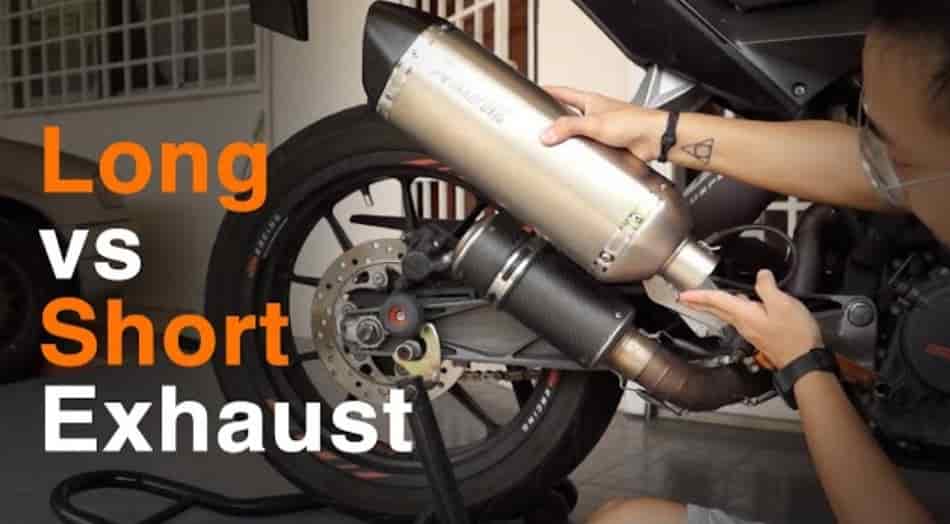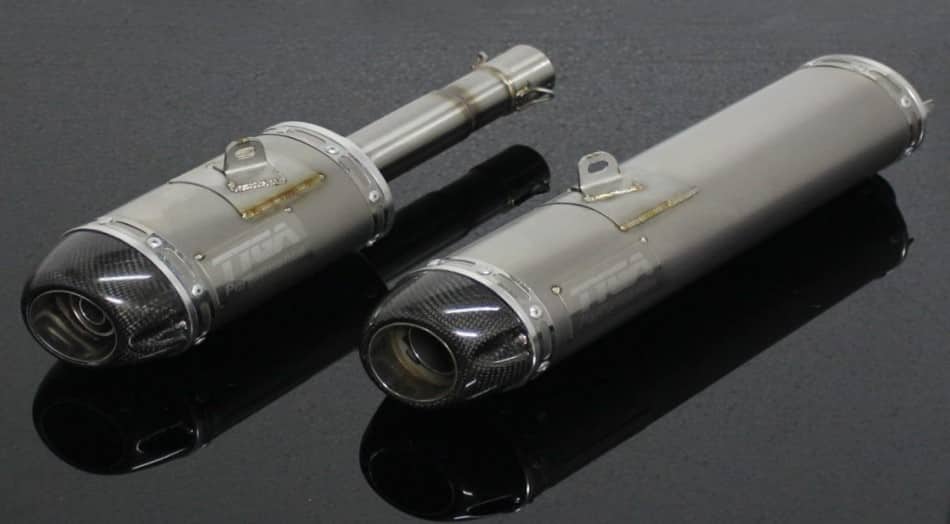Let’s explore short vs long exhaust pipe in motorcycles! The exhaust system plays a crucial role in the overall performance of a vehicle, and one of its key components is the exhaust pipe. The design and length of the exhaust pipe can have a significant impact on the performance characteristics of an engine.
In this article, we will explore the fundamentals of short and long exhaust pipes and how they affect the performance of a vehicle. By understanding these differences, car enthusiasts and automotive enthusiasts can make informed decisions when it comes to optimizing their vehicle’s exhaust system for better performance.
Motorcycle Exhaust Pipe: Larger vs Smaller Diameter
The diameter of the exhaust pipes is another important factor to consider when it comes to optimizing the performance of a vehicle’s exhaust system. The diameter refers to the internal width of the pipe, and it can have a significant impact on the flow of exhaust gases.

A larger diameter exhaust pipe allows for better flow of exhaust gases, reducing backpressure and improving engine efficiency. This can result in increased horsepower and torque, as well as improved throttle response. However, it’s important to note that simply increasing the diameter without considering other factors may not always lead to better performance. The exhaust system should be properly tuned to match the engine’s characteristics and desired performance goals.
On the other hand, a smaller diameter exhaust pipe can be beneficial in certain situations, such as in turbocharged or supercharged engines. Smaller pipes can help maintain exhaust gas velocity, which is crucial for turbocharger or supercharger efficiency. By keeping the exhaust gases flowing at a higher velocity, the turbocharger or supercharger can spool up faster, resulting in improved performance at lower RPMs.
Ultimately, the diameter of the exhaust pipes should be chosen based on various factors, including the engine’s specific requirements, intended use of the vehicle, and desired performance goals. It’s recommended to consult with experts or professionals in the field to determine the optimal diameter for your vehicle’s exhaust system.
Motorcycle Exhaust: Short vs. Long Pipe
The length of the exhaust pipes is another important consideration when it comes to optimizing the performance of a vehicle’s exhaust system. The length of the pipes can have a significant impact on the engine’s power delivery and overall performance characteristics.
In general, shorter exhaust pipes tend to provide better high-end power and top-end performance. This is because shorter pipes allow for quicker evacuation of exhaust gases, reducing backpressure and enabling the engine to breathe more efficiently at higher RPMs. This can result in improved horsepower and increased throttle response, making the vehicle feel more responsive and powerful at higher speeds.

On the other hand, longer exhaust pipes are known to enhance low-end torque and mid-range power. The increased length creates a scavenging effect, where exhaust gases help draw in fresh air-fuel mixture into the combustion chamber during the valve overlap period. This can improve low-end acceleration and enhance the engine’s torque output in the mid-range RPMs.
The optimal length of the exhaust pipes depends on several factors, including the engine’s displacement, camshaft profile, and intended use of the vehicle. Performance enthusiasts often experiment with different pipe lengths to find the ideal balance between high-end power and low-end torque for their specific engine setup and driving preferences.
It’s worth noting that there are various design considerations and trade-offs when it comes to exhaust pipe length, and the overall exhaust system should be properly tuned to maximize performance gains. Consulting with knowledgeable professionals or experts in the field can provide valuable insights and guidance in selecting the appropriate length for your vehicle’s exhaust pipes.
RPM Range for Pipe Length
The RPM range for pipe length refers to the engine speed range at which a particular length of exhaust pipe is optimized for performance. Different pipe lengths are designed to enhance performance within specific RPM ranges, and selecting the appropriate length can greatly impact the engine’s power delivery.
In general, longer exhaust pipes are effective in improving low-end torque and mid-range power. These lengths are typically optimized for lower RPM ranges, such as idle to mid-range RPMs. The longer pipe allows for better scavenging effect, where exhaust gases help draw in fresh air-fuel mixture into the combustion chamber during valve overlap, promoting efficient combustion and increasing torque output in the lower RPM range.

On the other hand, shorter exhaust pipes are known for enhancing high-end power and top-end performance. These lengths are optimized for higher RPM ranges, typically from mid-range to the redline. Shorter pipes enable quicker evacuation of exhaust gases, reducing backpressure and allowing the engine to breathe more efficiently at higher RPMs. This can result in improved horsepower and better throttle response at higher speeds.
It’s important to consider the specific characteristics of your engine, such as its displacement, camshaft profile, and powerband, when selecting the appropriate pipe length. Different engines have different RPM ranges where they produce optimal power, and choosing a pipe length that complements your engine’s powerband can result in better performance.
Ultimately, the RPM range for pipe length is a crucial factor to consider when designing or selecting an exhaust system. It’s recommended to consult with experts or professionals who can analyze your engine’s specifications and help determine the ideal pipe length for maximizing performance within your desired RPM range.
Is Backpressure Necessary?
Backpressure in an exhaust system is a topic that often generates debate among automotive enthusiasts. While some believe that backpressure is necessary for optimal engine performance, others argue that minimizing backpressure can lead to improved performance. To understand this better, let’s explore the concept of backpressure and its effects.
Backpressure refers to the resistance encountered by the exhaust gases as they flow through the exhaust system. It is caused by various factors, including the diameter and length of the exhaust pipes, mufflers, catalytic converters, and other components. A certain amount of backpressure is natural and necessary for the proper functioning of the engine.
Moderate levels of backpressure can have a positive effect on engine performance, particularly in naturally aspirated engines. It helps maintain exhaust gas velocity and promotes scavenging effects, where the flow of exhaust gases assists in drawing in fresh air-fuel mixture during valve overlap. This can improve low-end torque and mid-range power, making the engine more responsive in these RPM ranges.
However, excessive backpressure can have negative consequences on engine performance. It restricts the flow of exhaust gases, leading to reduced engine efficiency and potentially limiting horsepower and throttle response. This is particularly true in high-performance and forced induction engines, where minimizing backpressure is often desirable for optimal power delivery.
The ideal amount of backpressure depends on several factors, including the engine’s design, displacement, and intended use. It’s crucial to strike a balance between maintaining adequate backpressure for scavenging effects and minimizing excessive backpressure that hampers performance.
In modern vehicles, manufacturers strive to design exhaust systems that provide an optimal balance of backpressure for the engine’s requirements. Aftermarket modifications, such as installing a performance exhaust system, should be carefully chosen and tuned to ensure they provide the desired balance of backpressure and performance gains.
Ultimately, the necessity of backpressure in an exhaust system is a nuanced topic, and the ideal amount varies depending on the specific engine and its characteristics. Consulting with experts or professionals in the field can help determine the appropriate balance of backpressure for your vehicle’s engine, considering factors such as its design, intended use, and desired performance goals.
Short vs. Long Pipe Performance
When it comes to comparing short and long exhaust pipes for performance, there are distinct differences in their effects on an engine’s performance characteristics.
Short exhaust pipes are known to enhance high-end power and top-end performance. With shorter pipes, the exhaust gases can evacuate more quickly, reducing backpressure and allowing the engine to breathe more efficiently at higher RPMs. This results in improved horsepower and better throttle response at higher speeds. Short pipes are favored in applications where maximizing top-end performance and high RPM power is a priority, such as in racing or sports-oriented vehicles.
On the other hand, long exhaust pipes are often associated with improved low-end torque and mid-range power. The increased length creates a scavenging effect, where exhaust gases help draw in fresh air-fuel mixture into the combustion chamber during valve overlap. This enhances low-end acceleration and increases torque output in the mid-range RPMs. Longer pipes are commonly used in applications where strong low-end power and mid-range performance are desired, such as in off-road vehicles or vehicles used for towing.
It’s important to note that the selection of pipe length should consider various factors, including the engine’s specific characteristics, intended use of the vehicle, and desired performance goals. Additionally, the overall design of the exhaust system, including the diameter of the pipes and the presence of other components like mufflers and catalytic converters, also influences the performance outcomes.
In some cases, a compromise can be sought by using a mid-length exhaust pipe, which aims to strike a balance between high-end power and low-end torque. This approach can provide a more versatile performance across a wider RPM range.
Conclusion
Ultimately, the choice between short and long exhaust pipes depends on the specific requirements and goals of the engine and the vehicle. It’s recommended to consult with experts or professionals who can analyze the engine’s characteristics and provide guidance on selecting the optimal pipe length for achieving the desired performance outcomes.
